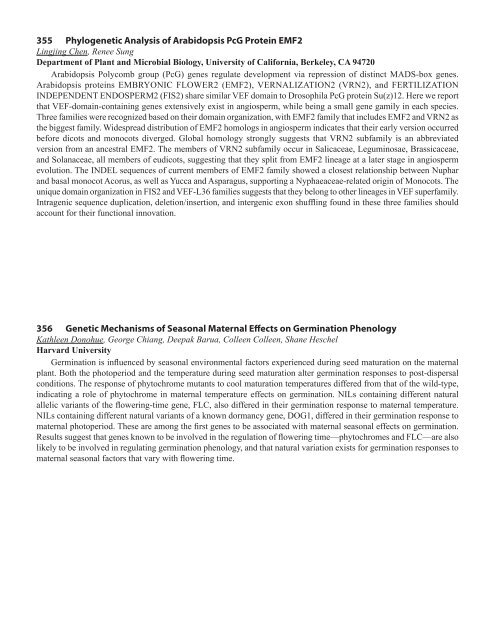75 Integrating Membrane Transport with Male Gametophyte ... - TAIR
75 Integrating Membrane Transport with Male Gametophyte ... - TAIR
75 Integrating Membrane Transport with Male Gametophyte ... - TAIR
You also want an ePaper? Increase the reach of your titles
YUMPU automatically turns print PDFs into web optimized ePapers that Google loves.
355 Phylogenetic Analysis of Arabidopsis PcG Protein EMF2<br />
Lingjing Chen, Renee Sung<br />
Department of Plant and Microbial Biology, University of California, Berkeley, CA 94720<br />
Arabidopsis Polycomb group (PcG) genes regulate development via repression of distinct MADS-box genes.<br />
Arabidopsis proteins EMBRYONIC FLOWER2 (EMF2), VERNALIZATION2 (VRN2), and FERTILIZATION<br />
INDEPENDENT ENDOSPERM2 (FIS2) share similar VEF domain to Drosophila PcG protein Su(z)12. Here we report<br />
that VEF-domain-containing genes extensively exist in angiosperm, while being a small gene gamily in each species.<br />
Three families were recognized based on their domain organization, <strong>with</strong> EMF2 family that includes EMF2 and VRN2 as<br />
the biggest family. Widespread distribution of EMF2 homologs in angiosperm indicates that their early version occurred<br />
before dicots and monocots diverged. Global homology strongly suggests that VRN2 subfamily is an abbreviated<br />
version from an ancestral EMF2. The members of VRN2 subfamily occur in Salicaceae, Leguminosae, Brassicaceae,<br />
and Solanaceae, all members of eudicots, suggesting that they split from EMF2 lineage at a later stage in angiosperm<br />
evolution. The INDEL sequences of current members of EMF2 family showed a closest relationship between Nuphar<br />
and basal monocot Acorus, as well as Yucca and Asparagus, supporting a Nyphaeaceae-related origin of Monocots. The<br />
unique domain organization in FIS2 and VEF-L36 families suggests that they belong to other lineages in VEF superfamily.<br />
Intragenic sequence duplication, deletion/insertion, and intergenic exon shuffling found in these three families should<br />
account for their functional innovation.<br />
356 Genetic Mechanisms of Seasonal Maternal Effects on Germination Phenology<br />
Kathleen Donohue, George Chiang, Deepak Barua, Colleen Colleen, Shane Heschel<br />
Harvard University<br />
Germination is influenced by seasonal environmental factors experienced during seed maturation on the maternal<br />
plant. Both the photoperiod and the temperature during seed maturation alter germination responses to post-dispersal<br />
conditions. The response of phytochrome mutants to cool maturation temperatures differed from that of the wild-type,<br />
indicating a role of phytochrome in maternal temperature effects on germination. NILs containing different natural<br />
allelic variants of the flowering-time gene, FLC, also differed in their germination response to maternal temperature.<br />
NILs containing different natural variants of a known dormancy gene, DOG1, differed in their germination response to<br />
maternal photoperiod. These are among the first genes to be associated <strong>with</strong> maternal seasonal effects on germination.<br />
Results suggest that genes known to be involved in the regulation of flowering time—phytochromes and FLC—are also<br />
likely to be involved in regulating germination phenology, and that natural variation exists for germination responses to<br />
maternal seasonal factors that vary <strong>with</strong> flowering time.





